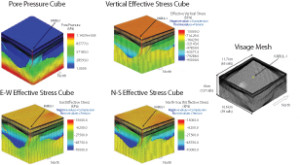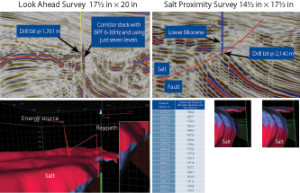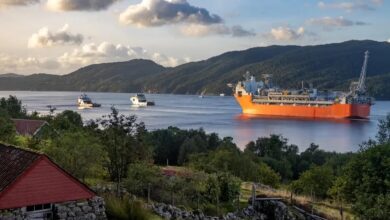Integrated approach delivers GOM subsalt well for PEMEX
Real-time drilling optimization key to pre-drill modeling, execution for complex exploratory well
By Victor Gerardo Vallejo, PEMEX; Manuel E. Torres and Luis Felipe Gonzalez, Schlumberger

As industry increasingly ventures into deeper waters characterized by complex reservoirs, the integration of upfront planning, risk management, workflow strategies and technologies that provide operational reliability are paramount. This trend has become evident in regions such as the Gulf of Mexico (GOM), where subsalt formations holding significant reserves are attracting operators. Despite risks of wellbore instability and lost circulation, technology has made exploration and development of these fields economically viable.
For its initial foray into the deepwater, subsalt arena, Petróleos Mexicanos (PEMEX) opted to avoid the risk of drilling directly through the salt dome in an exploratory well, choosing instead a more conservative drilling route around and underneath the salt flank. While less difficult in some respects, the option posed its own challenges, such as the need to design a more deviated trajectory and drill through the sheared, or rubble, zone commonly found under or adjacent to salt bodies, where there is a risk of becoming stuck.
The complexities of the project were addressed using a collaborative and integrated approach. The eight-month operation involved extensive upfront planning; pre-drill, 3D geomechanical modeling and simulation; contingency planning for multiple well sections; importing technology and hardware to the well site; real-time data surveillance; new technologies, such as seismic-vision-while-drilling, to guide the well under the salts, and the design of a long bottomhole assembly (BHA) to reach the target zone.
The well was drilled with a third-generation semisubmersible in 94 days, reaching a total depth of 5,350 meters (17,552 ft). The well included a 20-in. riserless section, an 8 ½-in. open-hole section and several sections that required multiple casing scenarios due to the need for contingencies to isolate problematic zones and manage the narrow mud weight drilling window between pore pressure and fracture pressure.
The real-time monitoring of drilling parameters and geomechanics service was also introduced during this project; it is a workflow process executed by Schlumberger that ties together various operational elements to mitigate risk.
The Kabilil-1 well was located in a Tertiary formation of the Mexican GOM, about 105.5 km (66 miles) northeast of Coatzacoalcos, Veracruz, and 253 km (157 miles) northwest of Ciudad del Carmen, Campeche, in a water depth of 739 meters (2,425 ft). The well exhibited an overhang feature covered by a large eroded area and was located in a structural trap on the eastern side of a large anticline that had been deformed by the effects of salt intrusion. The target reservoir held turbidites patterned in upwardly-thickening sections and amalgamated turbidites in channels where sandstone and mudstone deposits had led to an increase in elevation. Analysis indicated complex geology and sediments adjacent to the salt.
3D geomechanical modeling

In performing the initial risk assessment for determining the optimum drilling strategy, the technical teams prepared a pre-drilling analysis that included a finite-element numerical model and a 3D mechanical earth modeling simulator to predict the effects of the initial in-situ stresses, measure the influence of salt intrusion and induced pressures and earth stresses, and determine adequate mud weights.
The 3D simulator conducted a stress/strain analysis on a small section of the sedimentary layers and the salt bodies. Element models were taken from geologic structure maps using the VISAGE modeling software. The methodology incorporated data from one-dimensional mechanical earth models of several offset wells, property propagations using 3D seismic data and 3D finite element mechanical earth modeling. It also measured stresses and pore pressures to analyze wellbore stability along the proposed well path.
The stress/strain analysis showed significant variations in stress orientation and magnitude around the salt dome. A stress profile along the planned well path indicated an obvious increase in horizontal compressive stresses resulting from salt perturbations, as well as an increase in shear stresses at 1,500 meters to 2,100 meters (4,921 ft to 6,890 ft) total vertical depth, where shear stresses peaked. That depth range coincided with a decrease of vertical effective stress, indicating a high deformation zone with a fault at 2,100 meters (6,890 ft).
The analysis also suggested stress in surrounding sediments located more than 1.5 km (1 mile) from the salt dome. The 3D analysis of the mud weight window resulted in a plan with adequate mud weights.
Real-time monitoring of drilling parameters and geomechanics

Key to the validation of the pre-drill modeling and plan execution was the real-time drilling optimization program. The program requires teamwork between the operator and service company to address drilling risks, classified with a color-coded system, such as low rates of penetration, caved hole sections, well influxes, mud losses and BHA vibrations. It also provides a structured methodology for communication, where events are communicated from drilling optimization engineers and real-time geomechanics to decision-makers. For the Kabilil-1 well, the communication scenario included members of various disciplines (drilling engineers, geoscientists, rig crew members) from both companies.
Working in tandem with this program was the PEMEX multidisciplinary workflow program VCD-SE (Visualization, Conceptualization Development), also referred to as Front End Loading. It identifies the most critical risks during the pre-drill planning phase by building 3D and 1D mechanical earth models with data from offset wells.
The geo-modeling process produced several findings that served as the basis for developing the final drilling plan. Among them was the determination that drilling close to the salt dome would result in higher-than-expected collapse pressures at the end of the riserless section. This required optimizing the drilling fluid by combining seawater with weighted bentonite mud. Other hazards included:
• Shear stresses from the salt body influence would result in narrower mud weight windows for the 20-in. and 16-in. open-hole sections;
• The presence of a reverse fault in the open-hole sections posed the risk of well losses;
• Because the surface seismic model contained uncertainties regarding the precise location of the salt flank, the planned well trajectory would require precise navigation around the salt body. Drilling into the salt dome would add complexity to the operation;
• The well design would need to be optimized using unconventional casing (16-in. and 13 5/8-in. outer diameter strings) to allow two additional contingency casing strings (11 ¾-in. and 5 ½-in.) for the interval with the narrow drilling windows;
• Special underreaming BHA designs were required to perform simultaneous hole opening without the need for extra drilling runs. Due to the hole-opening initiatives, the BHAs would need to be stabilized with drilling simulators to minimize drilling vibrations that could destroy downhole tools and damage the borehole with BHA shocks;
• Continual equivalent circulating density would be required to minimize mud losses due to drilling-induced fractures or during the well cement process. A foam cement system would be required to optimize cement placement;
• Intermediate casing strings would need to be set at the appropriate depth to improve the drilling performance of the subsequent well sections, segregate the overpressure intervals induced by salt intrusion and separate incompatible formations.

In transitioning from the pre-drill planning stage to the execution phase, a drilling and engineering operations plan with a course of action for each well risk was created. Using the real-time drilling optimization process, offshore engineers and onshore geomechanics engineers worked together to update prediction models.
Real-time vision
Because the Kabilil well was an exploratory well, it was prudent to acquire LWD data while drilling to reduce uncertainties. The primary objective of the look-ahead seismic-while-drilling service was to reduce the depth uncertainties and identify potential risk zones. Additionally, LWD measurements were acquired for calibrating the geomechanical and pore pressure models.
For example, a real-time look-ahead-of-the-bit check shot and vertical seismic profile (VSP) of the interval between 1,500 meters and 2,200 meters (4,921 ft to 7,218 ft) was deployed in the 16-in. casing section where the fault plane had been predicted. The VSP data below the drill bit revealed homogeneous reflections rather than the strong amplitude that had been expected for salt presence.
The seismic-while-drilling information made it possible to precisely map the bit position and identify the location of the fault plane to set the 16-in. casing just below that point. When drilling resumed, the location of the fault plane was used to determine when to stop drilling for the 16-in. casing. The system also conducted a salt proximity survey in the 13 5/8-in. section, determining that the well was actually closer than expected to the salt dome, a minimum distance of approximately 163 meters (535 ft).
Real-time LWD tools, used for the initial formation evaluation and pore pressure predictions, were deployed in the 9 5/8-in. and 8 ½-in. open-hole sections to provide petrophysical information to determine whether further data was needed for each target zone.
The logging suite was enhanced with sonic to measure formation velocity for correlating seismic activity with the seismic model. The sonic log calculated the pore pressure profile, allowing geomechanical engineers to calibrate the mechanical earth model and devise a wellbore stability model that included a reliable collapse pressure, complementing the 3D modeling work performed in the pre-drill planning stage.
The PEMEX Kabilil-1 exploratory well demonstrated how optimum drilling performance can be achieved in a challenging deepwater subsalt well through the integration of effective pre-drill modeling, risk management, real-time monitoring and a workflow process built on strong communication and teamwork.
Although the well ultimately did not prove to not to be a viable producer and has since been abandoned, the successfully executed drilling program provided important lessons for the operator. PEMEX has since drilled 18 deepwater wells and four ultra-deepwater wells at water depths approaching 3,000 meters (9,843 ft) in the same basin.
VISAGE is a mark of Schlumberger.
References
Vallejo, V.G., Solis, E., Olivares, A., Aguilera,L.E., Torres, M.E. and Gonzalez, L. “Drilling a Deep-Water Well in a Subsalt Structure in Mexico”, Pennwell, Deep Offshore Technology International. ID number 145. Conference held in Perth, Australia 27–29 November 2012.
Aguilera, L.E., Jimenez, G., Lougon, A., Macias, J., Martinez, M. and Bracho, L., “Geomechanics and Pore Pressure Considerations for Successful Deep-water Exploration Drilling” paper SPE WVS 040
South American Oil and Gas Congress, organized by the SPE Western Venezuela Section, held in Maracaibo, Venezuela, 18–21 October 2011.
Sanchez, A, Mora, A. Aguilera and L.E, Gaitán, R., “Minimizing Drilling Risks for Exploration well in deepwater using Seismic While Drilling Technology”, in Rio Oil & Gas Expo and Conference 2010, held in Rio de Janeiro, Brazil, 13-16 September 2010.




